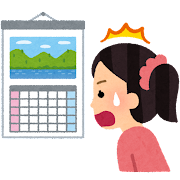Japanese Level 1, Activity #7: “Daily Activities” / “日々の活動” (Face-to-Face)

Image via Irasutoya
A simple presentation will introduce the students to a couple individuals’ simplified schedule. The presentation reviews the times of day and what activities someone would do throughout the day. The students will then build a small schedule for a character and practice presenting their schedule. At the end of the activity, students will talk about their own schedules.
Daily activities, schedule, character cards, 毎日の活動, スケジュール, 人物カード, Verb Conjugation, 五段活用, Verb Types and the “Present Tense”, 動詞の種類と「現在時制」, Particles, てにをは, Time References, 時間の参照, 〜ませんか, Frequency Adverbs, 頻度副詞, Word Order, 語順, The Topic Particle は, 話題の助詞は
Practices: Routines, Japanese business culture, showering then bathing
Perspectives: The importance of work culture and cleanliness
NCSSFL-ACTFL World-Readiness Standards:
- Standard 1.1: Students engage in conversation, provide and obtain information, express feelings and emotions, and exchange opinions.
- Standard 1.3: Students present information, concepts, and ideas to an audience of listeners or readers on a variety of topics.
Idaho Content Standards for World Languages:
- COMM 1.1: Interact and negotiate meaning (spoken, signed, written conversation) to share information, reactions, feelings, and opinions.
- COMM 3.1: Present information, concepts, and ideas to inform, explain, persuade, and narrate on a variety of topics using appropriate media in the target language.
NCSSFL-ACTFL Can-Do Statements:
- I can talk about my daily activities.
- I can introduce someone else and their daily schedule.
- I can understand my classmate’s presentation about their daily schedule.
Materials Needed
- Google Presentation
- Activity Cards
- Character Cards
Would you like to make changes to the materials? Access the template(s) below:
(Canva Template, free account required)
Warm-Up:
Pull up the presentation and greet your students in Japanese.
- こんにちは!
Move to the next slide with the “Can-Do Statements” and read each Can-Do statement in English.
「Can-Doステートメント」のスライドを見せて、Can-Doステートメントを英語で読みます。
Using the presentation, introduce Tanaka-san.
プレゼンテーションを使って、田中さんを紹介します。
Give his name, the time of day, and what activity he is doing.
彼の名前、時刻、および彼がしている活動を教えてください。
- This is Mr. Tanaka
- Mr. Tanaka gets up in the morning.
- He goes to school at noon.
- He has dinner at night.
- こちらは田中さんです。
- 朝、田中さんは起きます。
- 昼、学校に行きます。
- 夜、晩ご飯を食べます。
Check comprehension by reviewing the slide again, but this time ask the student questions about Tanaka.
理解度を確認するため、田中について学生に質問します。
- Who is this?
- What does Mr. Tanaka do in the morning/.
- What does he do at noon?
- What does he do at night?
- こちらは誰ですか?
- 朝、田中さんは何をしますか?
- 昼、何をしますか?
- 夜、何をしますか?
Next, go to the slide with Yamada-san
次に、山田さんのスライドを見せます。
Ask the students about her schedule
彼女のスケジュールについて生徒に尋ねる
Point to the picture of Yamada-san.
山田さんの写真を指さします。
- こちらは誰ですか?
Point to the picture of morning.
朝の写真を指さします。
- What does Mr. Yamada do in the morning?
- いつですか? 朝、山田さんは何をしますか?
Point to the picture of afternoon.
昼の写真を指してください。
- What does he do in the afternoon?
- いつですか? 昼、山田さんは何をしますか?
Point to the picture of night.
夜の写真を指さします。
- What does he do at night?
- いつですか? 夜、山田さんは何をしますか?
Main Activity:
In order to help the students, the last slide has 「(English word/phrase)は日本語で何と言いますか。」Have this slide up for the rest of the activity so students can start practicing with it!
最後のスライドは学生に役に立つので活動が終わったまで見せます。
Spread the activity cards out on the table and hand a character card to each student. The lab instructor will pick three activity cards (they can be from ANY time of day) and a character card (or just using yourself if there aren’t enough) and model the activity.
アクティビティカードをテーブルに広げ、学生にキャラクターカードを渡します。3枚のアクティビティカード(どれでも使用できます)とキャラクターカードを選び(または、足りない場合は自分で使用する)、活動のやり方を示します。
- This is a character
- I take a shower in the morning.
- I eat hamburgers at noon.
- I sleep at night.
- こちらは「キャラ」です。
- 朝、シャワーを浴びます。
- 昼、ハンバーガーを食べます。
- 夜、寝ます。
Have each student pick at least three activity cards for their character. These don’t need to be one morning card, one afternoon, one night. It can be any three cards.
- 三つのアクティビティカードを選んでください。
Put students in pairs and have them present what activities their character does to each other. (Yamamoto does this, this, and this.)
- 皆さん、ペアになってください。
- ペアで、あなたのキャラクターを紹介してください。
Once the students are done, they will present to the whole lab!
- 全員に紹介しましょう!
Wrap-Up:
Students now talk about what they do during their days!
学生たちは今、自分たちが日々に何をするのかについて話します!
- 朝、皆さんは何をしますか?
- 昼、何をしますか?
- 夜、何をしますか?
End of activity:
- Read Can-Do statements once more and have students evaluate
their confidence.
(Use thumbs up/thumbs down or download our student cards.) - Encourage students to be honest in their self-evaluation.
- Pay attention, and try to use feedback for future activities!
NCSSFL-ACTFL Can-Do Statements:
- I can talk about my daily activities.
- I can introduce someone else and their daily schedule.
- I can understand my classmate’s presentation about their daily schedule.

